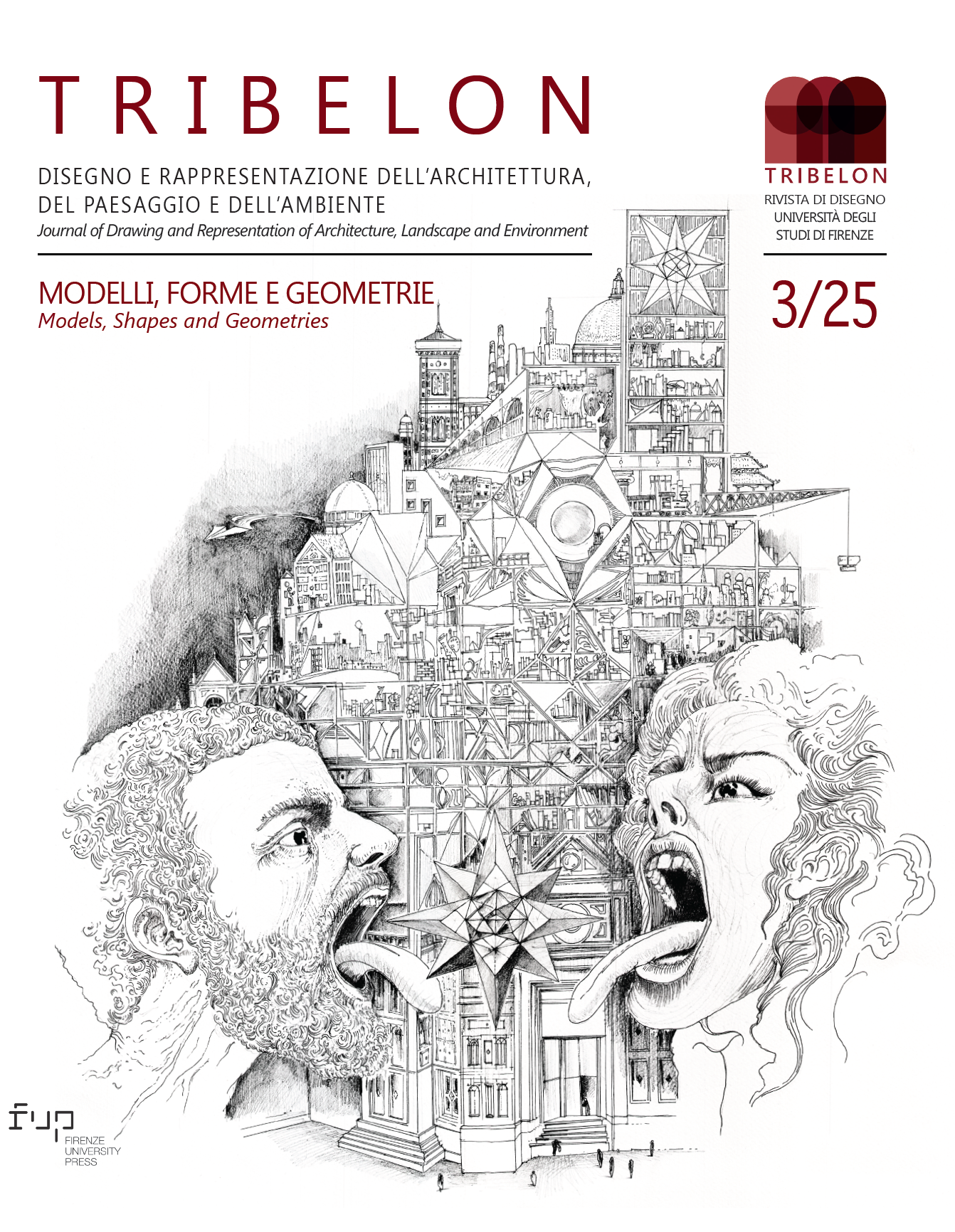Published 2025-06-09
Keywords
- Geometric Principles,
- Form Generation,
- Hybrid Visualisation,
- Regular Polyhedra,
- Holography
How to Cite
Copyright (c) 2025 Beniamino Polimeni, Martin Richardson, Oliver Peacock

This work is licensed under a Creative Commons Attribution 4.0 International License.
Abstract
The combination of digital and traditional methodologies in visualisation is an integral aspect of architectural and design practice. This integration is particularly evident in the generation of forms and shapes, from initial conception to realisation, facilitating the interplay of diverse fields. These hybrid methods involve volumetric transformations grounded in geometric principles, defining tools for generating and analysing shapes by incorporating 3d modelling and advanced manufacturing techniques.
This paper critically reflects on the relationship between geometry and form development by exploring the geometrical transformations of regular polyhedra. Using operative design as a tool for spatial formation, a catalogue of shapes is generated to examine how their combination can inform potential design processes. The physical and geometric qualities of the objects produced are analysed using 3D-printed models, complemented by traditional holographic representations. In particular, optical holography is employed as a visualisation medium, offering dynamic and immersive perspectives and revealing the complexity of geometric forms, engaging the viewer in a multidimensional experience.
This research highlights the fundamental role of geometry in architecture and design, encouraging the development of a structured framework of geometric principles and operations. This framework is designed to support iterative and dynamic design processes, enhancing the understanding of spatial relationships and serving as a heuristic tool for addressing the challenges of spatial complexity.
References
- E. Akleman, O. Ozener, C. Yuksel, On a Family of Symmetric, Connected and High Genus Sculptures, in Bridges London: Mathematics, Music, Art, Architecture, Culture, Southwestern College, London 2006, pp. 145–150.
- P. A. Blanche, Holography, and the Future of 3D Display, in Light: Advanced Manufacturing, II, 2021, 4, pp. 446–459.
- F. H. Bool, et al., M.C. Escher: His Life and Complete Graphic Work, Meulenhoff, Amsterdam 1981.
- H. Brisson, Visualization in Art and Science, in Leonardo, XXV, 1992, 3/4, p. 257-262.
- M. Brückner, Vielecke und Vielflache, Theorie und Geschichte, B.G. Teubner, Leipzig 1900.
- I. Caetano, L. Santos, A. Leitão, Computational Design in Architecture: Defining Parametric, Generative, and Algorithmic Design, in Frontiers of Architectural Research, IX, 2020, 2, pp. 287–300.
- P. Calter, The Platonic Solids, 2017, from https://www.dartmouth.edu/~matc/math5.geometry/unit6/unit6.html.
- J. Choma, Études for Architects, Routledge, London 2018.
- M. Colletti, Digital Poetics: An Open Theory of Design-Research in Architecture, Routledge, London–New York 2017.
- A. Di Mari, N. Yoo, Conditional Design, BIS, Amsterdam 2017.
- A. Di Mari, N. Yoo, Operative Design, BIS, Amsterdam 2012.
- M. Emmer, Art and Mathematics: The Platonic Solids, in Leonardo, XV, 1982, 2, p. 277.
- E. Giusti, C. Maccagni, Luca Pacioli e la matematica del Rinascimento, Giunti, Firenze 1994.
- B. Grossman, Pure Math, from https://www.bathsheba.com/math/.
- M. Hansmeyer, Computational Architecture: Platonic Solids, from https://www.michael-hansmeyer.com/platonic-solids.
- G. W. Hart, Geometric Sculpture, from https://www.georgehart.com/sculpture/sculpture.html.
- Z. Hecker, The Cube and the Dodecahedron in My Polyhedric Architecture, in Leonardo, XIII, 1980, 4, p. 272.
- S. Johnston, Holograms: The Story of a Word and Its Cultural Uses, in Leonardo, L, 2017, 5, pp. 493–499.
- A. Kudless, Drawing Codes, ACC Distributed, London 2024.
- D. N. Marshall, Carved Stone Balls, in Proceedings of the Society of Antiquaries of Scotland, 1976–1977, 108, pp. 4–72.
- N. Nishida, Correction of the Shrinkage of a Photographic Emulsion with Triethanolamine, in Applied Optics, IX, 1970, 1, pp. 238–240.
- S. Odoulov et al., Interference and Holography with Femtosecond Laser Pulses of Different Colours, in Nature Communications, VI, 2015, 1, 5866.
- M. J. Richardson, J. D. Wiltshire, The Hologram: Principles and Techniques, John Wiley & Sons, 2017.
- G. Saxby, Practical Holography, CRC Press, 2003.
- G. W. Hart, Geometric Sculpture, from https://www.georgehart.com/sculpture/sculpture.html.


